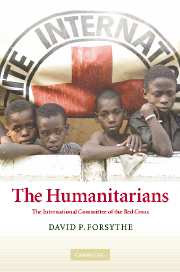Book contents
- Frontmatter
- Contents
- Preface
- List of abbreviations
- Introduction
- PART ONE Historical analysis
- PART TWO Policy analysis
- PART THREE Conclusion
- 8 Conclusion: the ICRC and the future
- Annexe A The ICRC and the Red Cross movement
- Annexe B The ICRC and selected private relief agencies
- Annexe C The ICRC: one of the Big Four relief agencies
- Annexe D The ICRC and selected advocacy groups
- Annexe E The ICRC organizational chart
- Bibliography
- Index
8 - Conclusion: the ICRC and the future
Published online by Cambridge University Press: 06 July 2010
- Frontmatter
- Contents
- Preface
- List of abbreviations
- Introduction
- PART ONE Historical analysis
- PART TWO Policy analysis
- PART THREE Conclusion
- 8 Conclusion: the ICRC and the future
- Annexe A The ICRC and the Red Cross movement
- Annexe B The ICRC and selected private relief agencies
- Annexe C The ICRC: one of the Big Four relief agencies
- Annexe D The ICRC and selected advocacy groups
- Annexe E The ICRC organizational chart
- Bibliography
- Index
Summary
There are human and inhuman warriors, just and unjust wars, forms of killing that are necessary and forms that dishonor us all. The Red Cross has become the keeper of these distinctions; they are the sentinels between the human and the inhuman.
Ignatieff, The Warrior's Honor, 1999, p. 161The International Committee of the Red Cross and its multifaceted activity since 1863 present a complex picture, full of paradoxes. To reiterate points made in the introduction, it is an organization that is primarily private but with public dimensions. It manifests liberal ends but conservative means, championing the worth of the individual but proceeding cautiously on the basis of state consent – which can be slow in manifesting itself. It professes to be non-political but is inherently part of humanitarian politics. It promotes international humanitarian law (IHL) but resorts to public legal judgments mostly as a last resort, preferring to emphasize pragmatic – if principled – service. It is a product of, and is generally sustained by, western (Judeo-Christian) values, but presents itself as a secular and global Good Samaritan. It is part of an international network officially devoted to universal humanitarianism, but one characterized historically by strong nationalism, including in the past Swiss nationalism. It emphasizes a limited mandate, but over time has expanded its activities broadly. Understandably, Caroline Morehead wrote that “the International Committee itself remained a curious animal.”
- Type
- Chapter
- Information
- The HumanitariansThe International Committee of the Red Cross, pp. 281 - 315Publisher: Cambridge University PressPrint publication year: 2005



